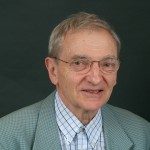Link to Pubmed [PMID] – 12200432
J. Biol. Chem. 2002 Nov;277(44):41657-66
At several E. coli promoters, initiation of transcription is repressed by a tight nucleoprotein complex formed by the assembly of the H-NS protein. In order to characterize the relationship between the structure of H-NS oligomers in solution and on relevant DNA fragments, we have compared wild-type H-NS and several transdominant H-NS mutants using gel shift assays, DNase I footprinting, analytical ultracentrifugation, and reactivity toward a cross-linking reagent. In solution, oligomerization occurs through two protein interfaces, one necessary to construct a dimeric core (and involving residues 1-64) and the other required for subsequent assembly of these dimers. We show that, as well as region 64-95, residues present in the NH(2)-terminal coiled coil domain also participate in this second interface. Our results support the view that the same interacting interfaces are also involved on the DNA. We propose that the dimeric core recognizes specific motifs, with the second interface being critical for their correct head to tail assembly. The COOH-terminal domain of the protein contains the DNA binding motif essential for the discrimination of this specific functional assembly over competitive nonspecific H-NS polymers.
